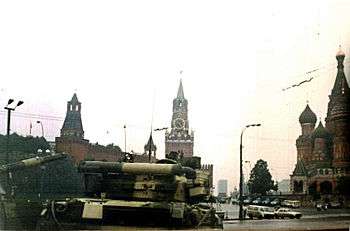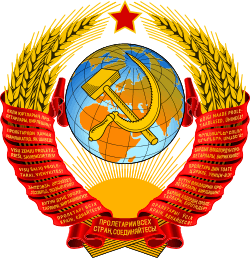Dissolution of the Soviet Union
|
Tanks at Red Square during the 1991 Soviet coup d'état attempt | |
| Date | December 26, 1991[1] |
|---|---|
| Location | Soviet Union |
| Participants | |
| Outcome |
Dissolution of the Soviet Union into independent republics |

|
|
|
|
| Eastern Bloc |
|---|
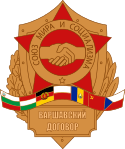 |
|
Allied states |
|
Dissent and opposition 1953 uprisings
1956 protests
|
The Soviet Union was dissolved on December 26, 1991, as a result of the declaration no. 142-Н of the Soviet of the Republics of the Supreme Soviet of the Soviet Union.[1] The declaration acknowledged the independence of the former Soviet republics and created the Commonwealth of Independent States (CIS), although five of the signatories ratified it much later or not at all. On the previous day, Soviet President Mikhail Gorbachev, the eighth and final leader of the Soviet Union, resigned, declared his office extinct, and handed over its powers – including control of the Soviet nuclear missile launching codes – to Russian President Boris Yeltsin. That evening at 7:32 p.m., the Soviet flag was lowered from the Kremlin for the last time and replaced with the pre-revolutionary Russian flag.[2]
Previously, from August to December, all the individual republics, including Russia itself, had seceded from the union. The week before the union's formal dissolution, 11 republics – all except the Baltic states and Georgia – signed the Alma-Ata Protocol formally establishing the CIS and declaring that the Soviet Union had ceased to exist.[3][4] The Revolutions of 1989 and the dissolution of the USSR (Russian: распад СССР) also signaled the end of the Cold War, which leaves the United States as the world's only superpower.
Several of the former Soviet republics have retained close links with the Russian Federation and formed multilateral organizations such as the Commonwealth of Independent States, Eurasian Economic Community, the Union State, the Eurasian Customs Union, and the Eurasian Economic Union to enhance economic and security cooperation. Some have joined NATO and the European Union.
1985
Moscow: Mikhail Gorbachev, new General Secretary
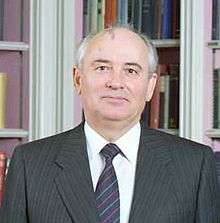
Mikhail Gorbachev was elected General Secretary by the Politburo on March 11, 1985, three hours after predecessor Konstantin Chernenko's death at age 73. Gorbachev, aged 54, was the youngest member of the Politburo. His initial goal as general secretary was to revive the Soviet economy, and he realized that doing so would require reforming underlying political and social structures.[5] The reforms began with personnel changes of senior Brezhnev-era officials who would impede political and economic change.[6] On April 23, 1985, Gorbachev brought two protégés, Yegor Ligachev and Nikolai Ryzhkov, into the Politburo as full members. He kept the "power" ministries happy by promoting KGB Head Viktor Chebrikov from candidate to full member and appointing Minister of Defence Marshal Sergei Sokolov as a Politburo candidate.
This liberalization, however, fostered nationalist movements and ethnic disputes within the Soviet Union. It also led indirectly to the revolutions of 1989, in which Soviet-imposed communist regimes of the Warsaw Pact were peacefully toppled (Romania excepted),[7] which in turn increased pressure on Gorbachev to introduce greater democracy and autonomy for the Soviet Union's constituent republics. Under Gorbachev's leadership, the Communist Party of the Soviet Union in 1989 introduced limited competitive elections to a new central legislature, the Congress of People's Deputies[8] (although the ban on other political parties was not lifted until 1990).[9]
In May 1985, Gorbachev delivered a speech in Leningrad advocating reforms and an anti-alcohol campaign to tackle widespread alcoholism. Prices of vodka, wine, and beer were raised in order to make these drinks more expensive and a disincentive to consumers, and the introduction of rationing. Unlike most forms of rationing intended to conserve scarce goods, this was done to restrict sales with the overt goal of curtailing drunkenness.[10] Gorbachev's plan also included billboards promoting sobriety, increased penalties for public drunkenness, and to censor drinking scenes from old movies. Some noted this mirrored Tsar Nicholas II's program during World War I, as that was also intended to eradicate drunkenness in order to bolster the war effort, although that was also intended to redirect grain usage for only the most essential purposes, which did not appear to be a goal in Gorbachev's program. However, Gorbachev soon faced the same adverse economic reaction to his prohibition as did the last Tsar. The disincentivization of alcohol consumption was a serious blow to the state budget according to Alexander Yakovlev, who noted annual collections of alcohol taxes decreased by 100 billion rubles. Alcohol production migrated to the black market, or through moonshining as some made "bathtub vodka" with homegrown potatoes. Poorer, less educated Russians resorted to drinking unhealthy substitutes such as nail-polish remover, rubbing alcohol or men's cologne, which only served to be an additional burden on Russia's healthcare sector due to the subsequent poisoning cases.[10] The purpose of these reforms, however, was to prop up the existing centrally planned economy, unlike later reforms, which tended toward market socialism.
On July 1, 1985, Gorbachev promoted Eduard Shevardnadze, First Secretary of the Georgian Communist Party, to full member of the Politburo, and the following day appointed him minister of foreign affairs, replacing longtime Foreign Minister Andrei Gromyko. The latter, disparaged as "Mr Nyet" in the West, had served for 28 years as Minister of Foreign Affairs. Gromyko was relegated to the largely ceremonial position of Chairman of the Presidium of the Supreme Soviet (officially Soviet Head of State), as he was considered an "old thinker." Also on July 1, Gorbachev took the opportunity to dispose of his main rival by removing Grigory Romanov from the Politburo, and brought Boris Yeltsin and Lev Zaikov into the CPSU Central Committee Secretariat.
In the fall of 1985, Gorbachev continued to bring younger and more energetic men into government. On September 27, Nikolai Ryzhkov replaced 79-year-old Nikolai Tikhonov as Chairman of the Council of Ministers, effectively the Soviet prime minister, and on October 14, Nikolai Talyzin replaced Nikolai Baibakov as chairman of the State Planning Committee (GOSPLAN). At the next Central Committee meeting on October 15, Tikhonov retired from the Politburo and Talyzin became a candidate. Finally, on December 23, 1985, Gorbachev appointed Yeltsin First Secretary of the Moscow Communist Party replacing Viktor Grishin.
1986
Sakharov
Gorbachev continued to press for greater liberalization. On December 23, 1986, the most prominent Soviet dissident, Andrei Sakharov, returned to Moscow shortly after receiving a personal telephone call from Gorbachev telling him that after almost seven years his internal exile for defying the authorities was over.[11]
Baltic republics
The Baltic republics, forcibly reincorporated into the Soviet Union in 1944,[12] pressed for independence, beginning with Estonia in November 1988 when the Estonian legislature passed laws resisting the control of the central government.[13]
Latvia's Helsinki-86

The CTAG (Latvian: Cilvēktiesību aizstāvības grupa, Human Rights Defense Group) Helsinki-86 was founded in July 1986 in the Latvian port town of Liepāja by three workers: Linards Grantiņš, Raimonds Bitenieks, and Mārtiņš Bariss. Its name refers to the human-rights statements of the Helsinki Accords. Helsinki-86 was the first openly anti-Communist organization in the U.S.S.R., and the first openly organized opposition to the Soviet regime, setting an example for other ethnic minorities' pro-independence movements.
On December 26, 1986, in the early morning hours after a rock concert, 300 working-class Latvian youths gathered in Riga's Cathedral Square and marched down Lenin Avenue toward the Freedom Monument, shouting, "Soviet Russia out! Free Latvia!" Security forces confronted the marchers, and several police vehicles were overturned.[14]
Central Asia
Kazakhstan: Jeltoqsan riots
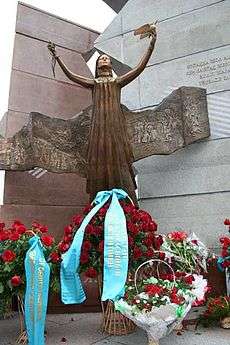
The "Jeltoqsan" (Kazakh for "December") of 1986 were riots in Alma-Ata, Kazakhstan, sparked by Gorbachev's dismissal of Dinmukhamed Konayev, the First Secretary of the Communist Party of Kazakhstan and an ethnic Kazakh, who was replaced with Gennady Kolbin, an outsider from the Russian SFSR.[15] Demonstrations started in the morning of December 17, 1986, with 200 to 300 students in front of the Central Committee building on Brezhnev Square protesting Konayev's dismissal and replacement by a Russian. Protesters swelled to 1,000 to 5,000 as other students joined the crowd. The CPK Central Committee ordered troops from the Ministry of Internal Affairs, druzhiniki (volunteers), cadets, policemen, and the KGB to cordon the square and videotape the participants. The situation escalated around 5 p.m., as troops were ordered to disperse the protesters. Clashes between the security forces and the demonstrators continued throughout the night in Almaty.
On the next day, December 18, protests turned into civil unrest as clashes between troops, volunteers, militia units, and Kazakh students turned into a wide-scale confrontation. The clashes could only be controlled on the third day. The Almaty events were followed by smaller protests and demonstrations in Shymkent, Pavlodar, Karaganda, and Taldykorgan. Reports from Kazakh SSR authorities estimated that the riots drew 3,000 people.[16] Other estimates are of at least 30,000 to 40,000 protestors with 5,000 arrested and jailed, and an unknown number of casualties.[17] Jeltoqsan leaders say over 60,000 Kazakhs participated in the protests.[17][18] According to the Kazakh SSR government, there were two deaths during the riots, including a volunteer police worker and a student. Both of them had died due to blows to the head. About 100 others were detained and several others were sentenced to terms in labor camps.[19] Sources cited by the Library of Congress claimed that at least 200 people died or were summarily executed soon thereafter; some accounts estimate casualties at more than 1,000. The writer Mukhtar Shakhanov claimed that a KGB officer testified that 168 protesters were killed, but that figure remains unconfirmed.
1987
Moscow: One-party democracy
At the January 28–30, 1987, Central Committee plenum, Gorbachev suggested a new policy of "Demokratizatsiya" throughout Soviet society. He proposed that future Communist Party elections should offer a choice between multiple candidates, elected by secret ballot. However, the CPSU delegates at the Plenum watered down Gorbachev's proposal, and democratic choice within the Communist Party was never significantly implemented.
Gorbachev also radically expanded the scope of Glasnost, stating that no subject was off-limits for open discussion in the media. Even so, the cautious Soviet intelligentsia took almost a year to begin pushing the boundaries to see if he meant what he said. For the first time, the Communist Party leader had appealed over the heads of Central Committee members for the people's support in exchange for expansion of liberties. The tactic proved successful: Within two years political reform could no longer be sidetracked by Party "conservatives." An unintended consequence was that having saved reform, Gorbachev's move ultimately killed the very system it was designed to save.[20]
On February 7, 1987, dozens of political prisoners were freed in the first group release since Khrushchev's "thaw" in the mid-1950s.[21] On May 6, 1987, Pamyat, a Russian nationalist group, held an unsanctioned demonstration in Moscow. The authorities did not break up the demonstration and even kept traffic out of the demonstrators' way while they marched to an impromptu meeting with Boris Yeltsin, head of the Moscow Communist Party and at the time one of Gorbachev's closest allies.[22] On July 25, 1987, 300 Crimean Tatars staged a noisy demonstration near the Kremlin Wall for several hours, calling for the right to return to their homeland, from which they were deported in 1944; police and soldiers merely looked on.[23]
On September 10, 1987, after a lecture from hardliner Yegor Ligachev at the Politburo for allowing these two unsanctioned demonstrations in Moscow, Boris Yeltsin wrote a letter of resignation to Gorbachev, who had been holidaying on the Black Sea.[24] Gorbachev was stunned – no one had ever voluntarily resigned from the Politburo. At the October 27, 1987, plenary meeting of the Central Committee, Yeltsin, frustrated that Gorbachev had not addressed any of the issues outlined in his resignation letter, criticized the slow pace of reform, servility to the general secretary, and opposition from Ligachev that had led to his (Yeltsin's) resignation.[25] No one had ever addressed the Party leader so brazenly in front of the Central Committee since Leon Trotsky in the 1920s.[25] In his reply, Gorbachev accused Yeltsin of "political immaturity" and "absolute irresponsibility." No one backed Yeltsin.
Nevertheless, news of Yeltsin's insubordination and "secret speech" spread, and soon samizdat versions began to circulate. This marked the beginning of Yeltsin's rebranding as a rebel and rise in popularity as an anti-establishment figure. The following four years of political struggle between Yeltsin and Gorbachev played a large role in the dissolution of the USSR.[26] On November 11, 1987, Yeltsin was fired from the post of First Secretary of the Moscow Communist Party.
Baltic republics: Molotov–Ribbentrop protests
On August 23, 1987, on the 48th anniversary of the secret protocols of the 1939 Molotov Pact between Adolf Hitler and Joseph Stalin that ultimately turned the then-independent Baltic states over to the Soviet Union, thousands of demonstrators marked the occasion in the three Baltic capitals to sing independence songs and listen to speeches commemorating Stalin’s victims. The gatherings were sharply denounced in the official press and closely watched by the police, but were not interrupted.[27]
Latvia leads
On June 14, 1987, about 5,000 people gathered again at Freedom Monument in Riga, and laid flowers to commemorate the anniversary of Stalin's mass deportation of Latvians in 1941. This was the first large demonstration in the Baltic republics to commemorate the anniversary of an event contrary to official Soviet history. The authorities did not crack down on demonstrators, which encouraged more and larger demonstrations throughout the Baltic States. The next major anniversary after the August 23 Molotov Pact demonstration was on November 18, the date of Latvia’s independence in 1918. On November 18, 1987, hundreds of police and civilian militiamen cordoned off the central square to prevent any demonstration at Freedom Monument, but thousands lined the streets of Riga in silent protest regardless.[28]
Estonia’s first protests
In spring 1987, a protest movement arose against new phosphate mines in Estonia. Signatures were collected in Tartu, and students assembled in the university's main hall to express lack of confidence in the government. At a demonstration on May 1, 1987, young people showed up with banners and slogans despite an official ban. On August 15, 1987, former political prisoners formed the MRP-AEG group (Estonians for the Public Disclosure of the Molotov-Ribbentrop Pact), which was headed by Tiit Madisson. In September 1987, the Edasi newspaper published a proposal by Edgar Savisaar, Siim Kallas, Tiit Made, and Mikk Titma calling for Estonia's transition to autonomy. Initially geared toward economic independence, then toward a certain amount of political autonomy, the project, Isemajandav Eesti ("A Self-Managing Estonia") became known according to its Estonian acronym, IME, which means "miracle". On October 21, a demonstration dedicated to those who gave their lives in the 1918–1920 Estonian War of Independence took place in Võru, which culminated in a conflict with the militia. For the first time in years, the blue, black, and white national tricolor was publicly displayed.[29]
The Caucasus
Armenia: Environmental concerns and Nagorno-Karabakh

On October 17, 1987, about 3,000 Armenians demonstrated in Yerevan complaining about the condition of Lake Sevan, the Nairit chemicals plant, and the Metsamor Nuclear Power Plant, and air pollution in Yerevan. Police tried to prevent the protest but took no action to stop it once the march was underway. The demonstration was led by Armenian writers such as Silva Kaputikian, Zori Balayan, and Maro Margarian and leaders from the National Survival organization. The march originated at the Opera Plaza after speakers, mainly intellectuals, addressed the crowd.
The following day 1,000 Armenians participated in another demonstration calling for Armenian national rights in Karabagh. The demonstrators demanded the annexation of Nakhchivan and Nagorno-Karabakh to Armenia, and carried placards to that effect. The police tried to physically prevent the march and after a few incidents, dispersed the demonstrators. Nagorno-Karabakh would break out in violence the following year.[30]
1988
Moscow loses control
In 1988 Gorbachev started to lose control of two small but troublesome regions of the Soviet Union, as the Baltic republics were captured by their popular fronts, and the Caucasus descended into violence and civil war.
On July 1, 1988, the fourth and last day of a bruising 19th Party Conference, Gorbachev won the backing of the tired delegates for his last-minute proposal to create a new supreme legislative body called the Congress of People's Deputies. Frustrated by the old guard's resistance, Gorbachev embarked on a set of constitutional changes to try to separate party and state, and thereby isolate his conservative Party opponents. Detailed proposals for the new Congress of People's Deputies were published on October 2, 1988,[31] and to enable the creation of the new legislature the Supreme Soviet, during its November 29 – December 1, 1988, session, implemented amendments to the 1977 Soviet Constitution, enacted a law on electoral reform, and set the date of the election for March 26, 1989.[32]
On November 29, 1988, the Soviet Union ceased to jam all foreign radio stations, allowing Soviet citizens for the first time to have unrestricted access to news sources beyond Communist Party control.[33]
Baltic Republics
In 1986 and 1987 Latvia had been in the vanguard of the Baltic states in pressing for reform. In 1988 Estonia took over the lead role with the foundation of the Soviet Union's first popular front and starting to influence state policy.
Estonian Popular Front
The Estonian Popular Front was founded in April 1988. On June 16, 1988 Gorbachev replaced Karl Vaino, the "old guard" leader of the Communist Party of Estonia, with the comparatively liberal Vaino Väljas, the Soviet ambassador to Nicaragua.[34] In late June 1988, Väljas bowed to pressure from the Estonian Popular Front and legalized the flying of the old blue-white-black flag of Estonia, and agreed to a new state language law that made Estonian the official language of the Republic.[14]
On October 2, the Popular Front formally launched its political platform at a two-day congress. Väljas attended, gambling that the front could help Estonia become a model of economic and political revival, while moderating separatist and other radical tendencies.[35] On November 16, 1988, the Supreme Soviet of the Estonian SSR adopted a declaration of national sovereignty under which Estonian laws would take precedence over those of the Soviet Union.[36] Estonia's parliament also laid claim to the republic's natural resources including land, inland waters, forests, mineral deposits, and to the means of industrial production, agriculture, construction, state banks, transportation, and municipal services within the territory of Estonia's borders.[37]
Latvian Popular Front
The Latvian Popular Front was founded in June 1988. On October 4, Gorbachev replaced Boris Pugo, the "old guard" leader of the Communist Party of Latvia, with the more liberal Jānis Vagris. In October 1988 Vagris bowed to pressure from the Latvian Popular Front and legalized flying the former carmine red-and-white flag of independent Latvia, and on October 6 he passed a law making Latvian the country's official language.[14]
Lithuania’s Sąjūdis
The Popular Front of Lithuania, called Sąjūdis ("Movement"), was founded in May 1988. On October 19, 1988, Gorbachev replaced Ringaudas Songaila, the "old guard" leader of the Communist Party of Lithuania, with the relatively liberal Algirdas Mykolas Brazauskas. In October 1988 Brazauskas bowed to pressure from Sąjūdis and legalized the flying of the historic yellow-green-red flag of independent Lithuania, and in November 1988 passed a law making Lithuanian the country's official language.[14]
Rebellion in the Caucasus
Azerbaijan: Violence
On February 20, 1988, after a week of growing demonstrations in Stepanakert, capital of the Nagorno-Karabakh Autonomous Oblast (the Armenian majority area within Azerbaijan Soviet Socialist Republic), the Regional Soviet voted to secede and join with the Soviet Socialist Republic of Armenia.[38] This local vote in a small, remote part of the Soviet Union made headlines around the world; it was an unprecedented defiance of republican and national authorities. On February 22, 1988, in what became known as the "Askeran clash", two Azerbaijanis were killed by Karabakh police. These deaths, announced on state radio, led to the Sumgait Pogrom. Between February 26 and March 1, the city of Sumgait (Azerbaijan) saw violent anti-Armenian rioting during which 32 people were killed. The authorities totally lost control and occupied the city with paratroopers and tanks; nearly all of the 14,000 Armenian residents of Sumgait fled.[39]
Gorbachev refused to make any changes to the status of Nagorno Karabakh, which remained part of Azerbaijan. He instead sacked the Communist Party Leaders in both Republics – on May 21, 1988, Kamran Baghirov was replaced by Abdulrahman Vezirov as First Secretary of the Azerbaijan Communist Party. From July 23 to September 1988, a group of Azerbaijani intellectuals began working for a new organization called the Popular Front of Azerbaijan, loosely based on the Estonian Popular Front.[40] On September 17, when gun battles broke out between the Armenians and Azerbaijanis near Stepanakert, two soldiers were killed and more than two dozen injured.[41] This led to almost tit-for-tat ethnic polarization in Nagorno-Karabakh's two main towns: The Azerbaijani minority was expelled from Stepanakert, and the Armenian minority was expelled from Shusha.[42] On November 17, 1988, in response to the exodus of tens of thousands of Azerbaijanis from Armenia, a series of mass demonstrations began in Baku's Lenin Square, lasting 18 days and attracting half a million demonstrators. On December 5, 1988, the Soviet militia finally moved in, cleared the square by force, and imposed a curfew that lasted ten months.[43]
Armenia: Uprising
The rebellion of fellow Armenians in Nagorno-Karabakh had an immediate effect in Armenia itself. Daily demonstrations, which began in the Armenian capital Yerevan on February 18, initially attracted few people, but each day the Nagorno-Karabakh issue became increasingly prominent and numbers swelled. On February 20, a 30,000-strong crowd demonstrated in Theater Square, by February 22, there were 100,000, the next day 300,000, and a transport strike was declared, by February 25, there were close to 1 million demonstrators – about a quarter of Armenia's population.[44] This was the first of the large, peaceful public demonstrations that would become a feature of communism's overthrow in Prague, Berlin, and, ultimately, Moscow. Leading Armenian intellectuals and nationalists, including future first President of independent Armenia Levon Ter-Petrossian, formed the eleven-member Karabakh Committee to lead and organize the new movement.
Gorbachev again refused to make any changes to the status of Nagorno Karabakh, which remained part of Azerbaijan. Instead he sacked both Republics' Communist Party Leaders: On May 21, 1988, Karen Demirchian was replaced by Suren Harutyunyan as First Secretary of the Communist Party of Armenia. However, Harutyunyan quickly decided to run before the nationalist wind and on May 28, allowed Armenians to unfurl the red-blue-gold First Armenian Republic flag for the first time in almost 70 years.[45] On June 15, 1988, the Armenian Supreme Soviet adopted a resolution formally approving the idea of Nagorno Karabakh joining Armenia.[46] Armenia, formerly one of the most loyal Republics, had suddenly turned into the leading rebel republic. On July 5, 1988, when a contingent of troops was sent in to remove demonstrators by force from Yerevan's Zvartnots International Airport, shots were fired and one student protester was killed.[47] In September, further large demonstrations in Yerevan led to the deployment of armored vehicles.[48] In the autumn of 1988 almost all the 200,000 Azerbaijani minority in Armenia was expelled by Armenian Nationalists, with over 100 killed in the process[49] – this, after the Sumgait pogrom earlier that year carried out by Azerbaijanis against ethnic Armenians and subsequent expulsion of all Armenians from Azerbaijan. On November 25, 1988, a military commandant took control of Yerevan as the Soviet government moved to prevent further ethnic violence.[50]
On December 7, 1988, the Spitak earthquake struck, killing an estimated 25,000 to 50,000 people. When Gorbachev rushed back from a visit to the United States, he was so angered to be confronted by protesters calling for Nagorno-Karabakh to be made part of the Armenian Republic – during a natural disaster – that on December 11, 1988, he ordered the entire Karabakh Committee to be arrested.[51]
Georgia: First demonstrations
In November 1988 in Tbilisi, capital of Soviet Georgia, many demonstrators camped out in front of the republic's legislature calling for Georgia's independence[52] and in support of Estonia's declaration of sovereignty.[53]
The Western republics
Democratic Movement of Moldova
Beginning in February 1988, the Democratic Movement of Moldova (formerly Moldavia) organized public meetings, demonstrations, and song festivals, which gradually grew in size and intensity. In the streets, the center of public manifestations was the Stephen the Great Monument in Chişinău, and the adjacent park harboring Aleea Clasicilor (The "Alee of the Classics [of the Literature]"). On January 15, 1988, in a tribute to Mihai Eminescu at his bust on the Aleea Clasicilor, Anatol Şalaru submitted a proposal to continue the meetings. In the public discourse, the movement called for national awakening, freedom of speech, revival of Moldavian traditions, and for attainment of official status for the Romanian language and return to the Latin alphabet. The transition from "movement" (an informal association) to "front" (a formal association) was seen as a natural "upgrade" once a movement gained momentum with the public, and the Soviet authorities no longer dared to crack down on it.
Demonstrations in Lviv, Ukraine
On April 26, 1988, about 500 people participated in a march organized by the Ukrainian Cultural Club on Kiev's Khreschatyk Street to mark the second anniversary of the Chernobyl nuclear disaster, carrying placards with slogans like "Openness and Democracy to the End." Between May and June 1988, Ukrainian Catholics in western Ukraine celebrated the Millennium of Christianity in Kievan Rus' in secret by holding services in the forests of Buniv, Kalush, Hoshiv, and Zarvanytsia. On June 5, 1988, as the official celebrations of the Millennium were held in Moscow, the Ukrainian Cultural Club hosted its own observances in Kiev at the monument to St. Volodymyr the Great, the grand prince of Kievan Rus'.
On June 16, 1988, 6,000 to 8,000 people gathered in Lviv to hear speakers declare no confidence in the local list of delegates to the 19th Communist Party conference, to begin on June 29. On June 21, a rally in Lviv attracted 50,000 people who had heard about a revised delegate list. Authorities attempted to disperse the rally in front of Druzhba Stadium. On July 7, 10,000 to 20,000 people witnessed the launch of the Democratic Front to Promote Perestroika. On July 17, a group of 10,000 gathered in the village Zarvanytsia for Millennium services celebrated by Ukrainian Greek-Catholic Bishop Pavlo Vasylyk. The militia tried to disperse attendees, but it turned out to be the largest gathering of Ukrainian Catholics since Stalin outlawed the Church in 1946. On August 4, which came to be known as "Bloody Thursday," local authorities violently suppressed a demonstration organized by the Democratic Front to Promote Perestroika. Forty-one people were detained, fined, or sentenced to 15 days of administrative arrest. On September 1, local authorities violently displaced 5,000 students at a public meeting lacking official permission at Ivan Franko State University.
On November 13, 1988, approximately 10,000 people attended an officially sanctioned meeting organized by the cultural heritage organization Spadschyna, the Kyiv University student club Hromada, and the environmental groups Zelenyi Svit ("Green World") and Noosfera, to focus on ecological issues. From November 14–18, 15 Ukrainian activists were among the 100 human-, national- and religious-rights advocates invited to discuss human rights with Soviet officials and a visiting delegation of the U.S. Commission on Security and Cooperation in Europe (also known as the Helsinki Commission). On December 10, hundreds gathered in Kiev to observe International Human Rights Day at a rally organized by the Democratic Union. The unauthorized gathering resulted in the detention of local activists.[54]
Kurapaty, Byelorussia
The Partyja BPF (Belarusian Popular Front) was established in 1988 as a political party and cultural movement for democracy and independence, à la the Baltic republics’ popular fronts. The discovery of mass graves in Kurapaty outside Minsk by historian Zianon Pazniak, the Belarusian Popular Front’s first leader, gave additional momentum to the pro-democracy and pro-independence movement in Belarus.[55] It claimed that the NKVD performed secret killings in Kurapaty.[56] Initially the Front had significant visibility because its numerous public actions almost always ended in clashes with the police and the KGB.
1989
Moscow: Limited democratization
Spring 1989 saw the people of the Soviet Union exercising a democratic choice, albeit limited, for the first time since 1917, when they elected the new Congress of People's Deputies. Just as important was the uncensored live TV coverage of the legislature's deliberations, where people witnessed the previously feared Communist leadership being questioned and held accountable. This example fueled a limited experiment with democracy in Poland, which quickly led to the toppling of the Communist government in Warsaw that summer – which in turn sparked uprisings that overthrew communism in the other five Warsaw Pact countries before the end of 1989, the year the Berlin Wall fell. These events showed that the people of Eastern Europe and the Soviet Union did not support Gorbachev's drive to modernize Communism; rather, they preferred to abandon it altogether.
This was also the year that CNN became the first non-Soviet broadcaster allowed to beam its TV news programs to Moscow. Officially, CNN was available only to foreign guests in the Savoy Hotel, but Muscovites quickly learned how to pick up signals on their home televisions. That had a major impact on how Russians saw events in their country, and made censorship almost impossible.[57]
Congress of People’s Deputies of the Soviet Union

The month-long nomination period for candidates for the Congress of People's Deputies of the USSR lasted until January 24, 1989. For the next month, selection among the 7,531 district nominees took place at meetings organized by constituency-level electoral commissions. On March 7, a final list of 5,074 candidates was published; about 85% were Party members.
In the two weeks prior to the 1,500 district polls, elections to fill 750 reserved seats of public organizations, contested by 880 candidates, were held. Of these seats, 100 were allocated to the CPSU, 100 to the All-Union Central Council of Trade Unions, 75 to the Communist Youth Union (Komsomol), 75 to the Committee of Soviet Women, 75 to the War and Labour Veterans' Organization, and 325 to other organizations such as the Academy of Sciences. The selection process was done in April.
In the March 26 general elections, voter participation was an impressive 89.8%, and 1,958 (including 1,225 district seats) of the 2,250 CPD seats were filled. In district races, run-off elections were held in 76 constituencies on April 2 and 9 and fresh elections were organized on April 20 and 14 to May 23,[58] in the 199 remaining constituencies where the required absolute majority was not attained.[32] While most CPSU-endorsed candidates were elected, more than 300 lost to independent candidates such as Yeltsin, physicist Andrei Sakharov and lawyer Anatoly Sobchak.
In the first session of the new Congress of People's Deputies, from May 25 to June 9, hardliners retained control but reformers used the legislature as a platform for debate and criticism – which was broadcast live and uncensored. This transfixed the population; nothing like this freewheeling debate had ever been witnessed in the U.S.S.R. On May 29, Yeltsin managed to secure a seat on the Supreme Soviet,[59] and in the summer he formed the first opposition, the Inter-Regional Deputies Group, composed of Russian nationalists and liberals. Composing the final legislative group in the Soviet Union, those elected in 1989 played a vital part in reforms and the eventual breakup of the Soviet Union during the next two years.
On May 30, 1989, Gorbachev proposed that nationwide local elections, scheduled for November 1989, be postponed until early 1990 because there were still no laws governing the conduct of such elections. This was seen by some as a concession to local Party officials, who feared they would be swept from power in a wave of anti-establishment sentiment.[60]
On October 25, 1989, the Supreme Soviet voted to eliminate special seats for the Communist Party and other official organizations in national and local elections, responding to sharp popular criticism that such reserved slots were undemocratic. After vigorous debate, the 542-member Supreme Soviet passed the measure 254-85 (with 36 abstentions). The decision required a constitutional amendment, ratified by the full congress, which met December 12–25. It also passed measures that would allow direct elections for presidents of each of the 15 constituent republics. Gorbachev strongly opposed such a move during debate but was defeated.
The vote expanded the power of republics in local elections, enabling them to decide for themselves how to organize voting. Latvia, Lithuania, and Estonia had already proposed laws for direct presidential elections. Local elections in all the republics had already been scheduled to take place between December and March 1990.[61]
Loss of satellite states

The six Warsaw Pact countries of Eastern Europe, while nominally independent, were widely recognized in the international community as the Soviet satellite states. All had been occupied by the Soviet Red Army in 1945, had Soviet-style socialist states imposed upon them, and had very restricted freedom of action in either domestic or international affairs. Any moves towards real independence were suppressed by military force – in the Hungarian Revolution of 1956 and the Prague Spring in 1968. Gorbachev abandoned the oppressive and expensive Brezhnev Doctrine, which mandated intervention in the Warsaw Pact states, in favor of non-intervention in the internal affairs of allies – jokingly termed the Sinatra Doctrine in a reference to the Frank Sinatra song "My Way".
Baltic "Chain of Freedom"
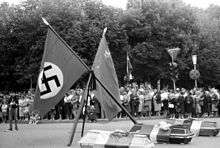
The Baltic Way or Baltic Chain (also Chain of Freedom Estonian: Balti kett, Latvian: Baltijas ceļš, Lithuanian: Baltijos kelias, Russian: Балтийский путь) was a peaceful political demonstration on August 23, 1989.[62] An estimated 2 million people joined hands to form a human chain extending 600 kilometres (370 mi) across Estonia, Latvia and Lithuania, which had been forcibly reincorporated into the Soviet Union in 1944. The colossal demonstration marked the 50th anniversary of the Molotov–Ribbentrop Pact that divided Eastern Europe into spheres of influence and led to the occupation of the Baltic states in 1940.
In December 1989, the Congress of People's Deputies accepted—and Gorbachev signed—the report by the Yakovlev Commission condemning the secret protocols of the Molotov–Ribbentrop pact.[63]
Lithuania’s Communist Party splits
In the March 1989 elections to the Congress of Peoples Deputies, 36 of the 42 deputies from Lithuania were candidates from the independent national movement Sąjūdis. This was the greatest victory for any national organization within the USSR and was a devastating revelation to the Lithuanian Communist Party of its growing unpopularity.[64]
On December 7, 1989, the Communist Party of Lithuania under the leadership of Algirdas Brazauskas, split from the Communist Party of the Soviet Union and abandoned its claim to have a constitutional "leading role" in politics. A smaller loyalist faction of the Communist Party, headed by hardliner Mykolas Burokevičius, was established and remained affiliated with the CPSU. However, Lithuania’s governing Communist Party was formally independent from Moscow's control – a first for Soviet Republics and a political earthquake that prompted Gorbachev to arrange a visit to Lithuania the following month in a futile attempt to bring the local party back under control.[65]
Caucasus
Azerbaijan’s blockade
On July 16, 1989, the Popular Front of Azerbaijan held its first congress and elected Abulfaz Elchibey, who would become President, as its Chairman.[66] On August 19, 600,000 protesters jammed Baku’s Lenin Square (now Azadliq Square) to demand the release of political prisoners.[67] In the second half of 1989, weapons were handed out in Nagorno-Karabakh. When Karabakhis got hold of small arms to replace hunting rifles and crossbows, casualties began to mount; bridges were blown up, roads were blockaded, and hostages were taken.[68]
In a new and effective tactic, the Popular Front launched a rail blockade of Armenia,[69] which caused petrol and food shortages because 85 percent of Armenia's freight came from Azerbaijan.[70] Under pressure from the Popular Front the Communist authorities in Azerbaijan started making concessions. On September 25, they passed a sovereignty law that gave precedence to Azerbaijani law, and on October 4, the Popular Front was permitted to register as a legal organization as long as it lifted the blockade. Transport communications between Azerbaijan and Armenia never fully recovered.[70] Tensions continued to escalate and on December 29, Popular Front activists seized local party offices in Jalilabad, wounding dozens.
Armenia’s Karabakh Committee released
On May 31, 1989, the 11 members of the Karabakh Committee, who had been imprisoned without trial in Moscow’s Matrosskaya Tishina prison, were released, and returned home to a hero's welcome.[71] Soon after his release, Levon Ter-Petrossian, an academic, was elected chairman of the anti-communist opposition Pan-Armenian National Movement, and later stated that it was in 1989 that he first began considering full independence.[72]
Massacre in Tbilisi, Georgia
On April 7, 1989, Soviet troops and armored personnel carriers were sent to Tbilisi after more than 100,000 people protested in front of Communist Party headquarters with banners calling for Georgia to secede from the Soviet Union and for Abkhazia to be fully integrated into Georgia.[73] On April 9, 1989, troops attacked the demonstrators; some 20 people were killed and more than 200 wounded.[74] This event radicalized Georgian politics, prompting many to conclude that independence was preferable to continued Soviet rule. On April 14, Gorbachev removed Jumber Patiashvili as First Secretary of the Georgian Communist Party and replaced him with former Georgian KGB chief Givi Gumbaridze.
On July 16, 1989, in Abkhazia's capital Sukhumi, a protest against the opening of a Georgian university branch in the town led to violence that quickly degenerated into a large-scale inter-ethnic confrontation in which 18 died and hundreds were injured before Soviet troops restored order.[75] This riot marked the start of the Georgian-Abkhaz conflict.
The Western republics
Popular Front of Moldova
In the March 26, 1989, elections to the Congress of People's Deputies, 15 of the 46 Moldavian deputies sent to Moscow were supporters of the Nationalist/Democratic movement.[76] The Popular Front of Moldova founding congress took place two months later, on May 20, 1989. During its second congress (June 30 – July 1, 1989), Ion Hadârcă was elected its president.
A series of demonstrations that became known as the Grand National Assembly (Romanian: Marea Adunare Naţională) was the Front’s first major achievement. Such mass demonstrations, including one attended by 300,000 people on August 27,[77] convinced the Moldavian Supreme Soviet on August 31 to adopt the language law making Moldovan the official language, and replacing the Cyrillic alphabet with Latin characters.[78]
Ukraine’s Rukh
In Ukraine, Lviv and Kiev celebrated Ukrainian Independence Day on January 22, 1989. Thousands gathered in Lviv for an unauthorized moleben (religious service) in front of St. George's Cathedral. In Kiev, 60 activists met in a Kiev apartment to commemorate the proclamation of the Ukrainian People's Republic in 1918. On February 11–12, 1989, the Ukrainian Language Society held its founding congress. On February 15, 1989, the formation of the Initiative Committee for the Renewal of the Ukrainian Autocephalous Orthodox Church was announced. The program and statutes of the movement were proposed by the Writers Association of Ukraine and were published in the journal Literaturna Ukraina on February 16, 1989. The organization heralded Ukrainian dissidents such as Vyacheslav Chornovil.
In late February, large public rallies took place in Kiev to protest the election laws, on the eve of the March 26 elections to the USSR Congress of People's Deputies, and to call for the resignation of the first secretary of the Communist Party of Ukraine, Volodymyr Shcherbytsky, lampooned as "the mastodon of stagnation." The demonstrations coincided with a visit to Ukraine by Soviet President Gorbachev. On February 26, 1989, between 20,000 and 30,000 people participated in an unsanctioned ecumenical memorial service in Lviv, marking the anniversary of the death of 19th Century Ukrainian artist and nationalist Taras Shevchenko.
On March 4, 1989, the Memorial Society, committed to honoring the victims of Stalinism and cleansing society of Soviet practices, was founded in Kiev. A public rally was held the next day. On March 12, A pre-election meeting organized in Lviv by the Ukrainian Helsinki Union and the Marian Society Myloserdia (Compassion) was violently dispersed, and nearly 300 people were detained. On March 26, elections were held to the union Congress of People's Deputies; by-elections were held on April 9, May 14, and May 21. Among the 225 Ukrainian deputies, most were conservatives, though a handful of progressives made the cut.
From April 20–23, 1989, pre-election meetings were held in Lviv for four consecutive days, drawing crowds of up to 25,000. The action included a one-hour warning strike at eight local factories and institutions. It was the first labor strike in Lviv since 1944. On May 3, a pre-election rally attracted 30,000 in Lviv. On May 7, The Memorial Society organized a mass meeting at Bykivnia, site of a mass grave of Ukrainian and Polish victims of Stalinist terror. After a march from Kiev to the site, a memorial service was staged.
From mid-May to September 1989, Ukrainian Greek-Catholic hunger strikers staged protests on Moscow's Arbat to call attention to the plight of their Church. They were especially active during the July session of the World Council of Churches held in Moscow. The protest ended with the arrests of the group on September 18. On May 27, 1989, the founding conference of the Lviv regional Memorial Society was held. On June 18, 1989, an estimated 100,000 faithful participated in public religious services in Ivano-Frankivsk in western Ukraine, responding to Cardinal Myroslav Lubachivsky's call for an international day of prayer.
On August 19, 1989, the Russian Orthodox Parish of Saints Peter and Paul announced it would be switching to the Ukrainian Autocephalous Orthodox Church. On September 2, 1989, tens of thousands across Ukraine protested a draft election law that reserved special seats for the Communist Party and for other official organizations: 50,000 in Lviv, 40,000 in Kiev, 10,000 in Zhytomyr, 5,000 each in Dniprodzerzhynsk and Chervonohrad, and 2,000 in Kharkiv. From September 8–10, 1989, writer Ivan Drach was elected to head Rukh, the People's Movement of Ukraine, at its founding congress in Kiev. On September 17, between 150,000 and 200,000 people marched in Lviv, demanding the legalization of the Ukrainian Greek Catholic Church. On September 21, 1989, exhumation of a mass grave begins in Demianiv Laz, a nature preserve south of Ivano-Frankivsk. On September 28, First Secretary of the Communist Party of the Ukraine Volodymyr Shcherbytsky, a holdover from the Brezhnev era, was replaced by Vladimir Ivashko.
On October 1, 1989, a peaceful demonstration of 10,000 to 15,000 people was violently dispersed by the militia in front of Lviv's Druzhba Stadium, where a concert celebrating the Soviet "reunification" of Ukrainian lands was being held. On October 10, Ivano-Frankivsk was the site of a pre-election protest attended by 30,000 people. On October 15, several thousand people gathered in Chervonohrad, Chernivtsi, Rivne, and Zhytomyr; 500 in Dnipropetrovsk; and 30,000 in Lviv to protest the election law. On October 20, faithful and clergy of the Ukrainian Autocephalous Orthodox Church participated in a synod in Lviv, the first since its forced liquidation in the 1930s.
On October 24, the union Supreme Soviet passed a law eliminating special seats for Communist Party and other official organizations' representatives. On October 26, twenty factories in Lviv held strikes and meetings to protest the police brutality of October 1 and the authorities' unwillingness to prosecute those responsible. From October 26–28, the Zelenyi Svit (Friends of the Earth – Ukraine) environmental association held its founding congress, and on October 27 the Ukrainian Supreme Soviet passed a law eliminating the special status of party and other official organizations.
On October 28, 1989, the Ukrainian Supreme Soviet decreed that effective January 1, 1990, Ukrainian would be the official language of Ukraine, while Russian would be used for communication between ethnic groups. On the same day The Congregation of the Church of the Transfiguration in Lviv left the Russian Orthodox Church and proclaimed itself the Ukrainian Greek Catholic Church. The following day, thousands attended a memorial service at Demianiv Laz, and a temporary marker was placed to indicate that a monument to the "victims of the repressions of 1939–1941" soon would be erected.
In mid-November The Shevchenko Ukrainian Language Society was officially registered. On November 19, 1989, a public gathering in Kiev attracted thousands of mourners, friends and family to the reburial in Ukraine of three inmates of the infamous Gulag Camp No. 36 in Perm in the Ural Mountains: human-rights activists Vasyl Stus, Oleksiy Tykhy, and Yuri Lytvyn. Their remains were reinterred in Baikove Cemetery. On November 26, 1989, a day of prayer and fasting was proclaimed by Cardinal Myroslav Lubachivsky, thousands of faithful in western Ukraine participated in religious services on the eve of a meeting between Pope John Paul II and Soviet President Gorbachev. On November 28, 1989, the Ukrainian SSR's Council for Religious Affairs issued a decree allowing Ukrainian Catholic congregations to register as legal organizations. The decree was proclaimed on December 1, coinciding with a meeting at the Vatican between the pope and the Soviet president.
On December 10, 1989, the first officially sanctioned observance of International Human Rights Day was held in Lviv. On December 17, an estimated 30,000 attended a public meeting organized in Kiev by Rukh in memory of Nobel laureate Andrei Sakharov, who died on December 14. On December 26, the Supreme Soviet of Ukrainian SSR adopted a law designating Christmas, Easter, and the Feast of the Holy Trinity official holidays.[54]
In May 1989, a Soviet dissident, Mustafa Dzhemilev, was elected to lead the newly founded Crimean Tatar National Movement. He also led the campaign for return of Crimean Tatars to their homeland in Crimea after 45 years of exile.
Byelorussia: Kurapaty

On January 24, 1989, the Soviet authorities in Byelorussia agreed to the demand of the democratic opposition to build a monument to thousands of people shot by Stalin-era police in the Kuropaty Forest near Minsk in the 1930s.[79]
On September 30, 1989, thousands of Byelorussians, denouncing local leaders, marched through Minsk to demand additional cleanup of the 1986 Chernobyl disaster site in Ukraine. Up to 15,000 protesters wearing armbands bearing radioactivity symbols and carrying the banned red-and-white Byelorussian national flag filed through torrential rain in defiance of a ban by local authorities. Later, they gathered in the city center near the government's headquarters, where speakers demanded resignation of Yefrem Sokolov, the republic's Communist Party leader, and called for the evacuation of half a million people from the contaminated zones.[80]
Central Asian republics
Fergana, Uzbekistan
Thousands of Soviet troops were sent to the Fergana Valley, southeast of the Uzbek capital Tashkent, to re-establish order after clashes in which local Uzbeks hunted down members of the Meskhetian minority in several days of rioting between June 4–11, 1989; about 100 people were killed.[81] On June 23, 1989, Gorbachev removed Rafiq Nishonov as First Secretary of the Communist Party of the Uzbek SSR and replaced him with Karimov, who went on to lead Uzbekistan as a Soviet Republic and subsequently as an independent state.
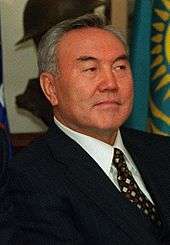
Zhanaozen, Kazakhstan
In Kazakhstan on June 19, 1989, young men carrying guns, firebombs, iron bars and stones rioted in Zhanaozen, causing a number of deaths. The youths tried to seize a police station and a water-supply station. They brought public transportation to a halt and shut down various shops and industries.[82] By June 25, the rioting had spread to five other towns near the Caspian Sea. A mob of about 150 people armed with sticks, stones and metal rods attacked the police station in Mangishlak, about 90 miles from Zhanaozen, before they were dispersed by government troops flown in by helicopters. Mobs of young people also rampaged through Yeraliev, Shepke, Fort-Shevchenko and Kulsary, where they poured flammable liquid on trains housing temporary workers and set them on fire.[83]
On June 22, 1989, Gorbachev removed Gennady Kolbin (the ethnic Russian whose appointment caused riots in December 1986) as First Secretary of the Communist Party of Kazakhstan for his poor handling of the June events, and replaced him with Nazarbayev, an ethnic Kazakh who went on to lead Kazakhstan as a Soviet Republic and subsequently as an independent state for decades.
1990
Moscow loses six republics
On February 7, 1990, the Central Committee of the CPSU accepted Gorbachev’s recommendation that the party give up its monopoly on political power.[84] In 1990, all fifteen constituent republics of the USSR held their first competitive elections, with reformers and ethnic nationalists winning many seats. The CPSU lost the elections in six republics:
- In Lithuania, to Sąjūdis, on February 24 (run-off elections on March 4, 7, 8, and 10).
- In Moldova, to the Popular Front of Moldova, on February 25.
- In Estonia, to the Estonian Popular Front, on March 18.
- In Latvia, to the Latvian Popular Front, on March 18 (run-off elections on March 25, April 1, and April 29).
- In Armenia, to the Pan-Armenian National Movement, on May 20 (run-off elections on June 3 and July 15).
- In Georgia, to Round Table-Free Georgia, on October 28 (run-off election on November 11).
The constituent republics began to declare their national sovereignty and began a "war of laws" with the Moscow central government; they rejected union-wide legislation that conflicted with local laws, asserted control over their local economy and refused to pay taxes. This conflict caused economic dislocation as supply lines were disrupted, and caused the Soviet economy to decline further.[85]
Rivalry between USSR and RSFSR
On March 4, 1990, the Russian Soviet Federative Socialist Republic held relatively free elections for the Congress of People's Deputies of Russia. Boris Yeltsin was elected, representing Sverdlovsk, garnering 72 percent of the vote.[86] On May 29, 1990, Yeltsin was elected chair of the Presidium of the Supreme Soviet of the RSFSR, despite the fact that Gorbachev asked Russian deputies not to vote for him.
Yeltsin was supported by democratic and conservative members of the Supreme Soviet, who sought power in the developing political situation. A new power struggle emerged between the RSFSR and the Soviet Union. On June 12, 1990, the Congress of People's Deputies of the RSFSR adopted a declaration of sovereignty. On July 12, 1990, Yeltsin resigned from the Communist Party in a dramatic speech at the 28th Congress.[87]
Baltic republics
Lithuania
Gorbachev’s visit to the Lithuanian capital Vilnius on January 11–13, 1990, provoked a pro-independence rally attended by an estimated 250,000 people.
On March 11, the newly elected parliament of the Lithuanian SSR elected Vytautas Landsbergis, the leader of Sąjūdis, as its chairman and proclaimed the Act of the Re-Establishment of the State of Lithuania, making Lithuania the first Soviet Republic to break away from the USSR. Moscow reacted with an economic blockade keeping the troops in Lithuania ostensibly "to secure the rights of ethnic Russians".[88]

Estonia
On March 25, 1990, the Estonian Communist Party voted to split from the CPSU after a six-month transition.[89]
On March 30, 1990, the Estonian Supreme Council declared the Soviet occupation of Estonia since World War II to be illegal and began reestablishing Estonia as an independent state.
On April 3, 1990, Edgar Savisaar of the Popular Front of Estonia was elected Chairman of the Council of Ministers (the equivalent of being Estonia's Prime Minister).

Latvia
Latvia declared the restoration of independence on May 4, 1990, with the declaration stipulating a transitional period to complete independence. The Declaration stated that although Latvia had de facto lost its independence in World War II, the country had de jure remained a sovereign country because the annexation had been unconstitutional and against the will of the Latvian people.
The declaration also stated that Latvia would base its relationship with the Soviet Union on the basis of the Latvian–Soviet Peace Treaty of 1920, in which the Soviet Union recognized Latvia's independence as inviolable "for all future time". May 4 is a national holiday in Latvia.
On May 7, 1990, Ivars Godmanis of the Latvian Popular Front was elected Chairman of the Council of Ministers (the equivalent of being Latvia's Prime Minister).
Caucasus
Azerbaijan’s Black January
During the first week of January 1990, in the Azerbaijani exclave of Nakhchivan, the Popular Front led crowds in the storming and destruction of the frontier fences and watchtowers along the border with Iran, and thousands of Soviet Azerbaijanis crossed the border to meet their ethnic cousins in Iranian Azerbaijan.[90] It was the first instance the Soviet Union had lost control of an external border.

Ethnic tensions had escalated between the Armenians and Azerbaijanis in spring and summer 1988.[91] On January 9, 1990, after the Armenian parliament voted to include Nagorno-Karabakh within its budget, renewed fighting broke out, hostages were taken, and four Soviet soldiers were killed.[92] On January 11, Popular Front radicals stormed party buildings and effectively overthrew the communist powers in the southern town of Lenkoran.[92] Gorbachev resolved to regain control of Azerbaijan; the events that ensued are known as "Black January." Late on January 19, 1990, after blowing up the central television station and cutting the phone and radio lines, 26,000 Soviet troops entered the Azerbaijani capital Baku, smashing barricades, attacking protesters, and firing into crowds. On that night and during subsequent confrontations (which lasted until February), more than 130 people died – the majority of whom were civilians. More than 700 civilians were wounded, hundreds were detained, but only a few were actually tried for alleged criminal offenses.
Civil liberties suffered. Soviet Defence Minister Dmitry Yazov stated that the use of force in Baku was intended to prevent the de facto takeover of the Azerbaijani government by the non-communist opposition, to prevent their victory in upcoming free elections (scheduled for March 1990), to destroy them as a political force, and to ensure that the Communist government remained in power. This marked the first time the Soviet Army took one of its own cities by force.[93]
The army had gained control of Baku, but by January 20 it essentially lost Azerbaijan. Nearly the entire population of Baku turned out for the mass funerals of "martyrs" buried in the Alley of Martyrs.[93] Thousands of Communist Party members publicly burned their party cards. First Secretary Vezirov decamped to Moscow and Ayaz Mutalibov was appointed his successor in a free vote of party officials. The ethnic Russian Viktor Polyanichko remained second secretary and the power behind the throne.[94]
Following the hardliners' takeover, the September 30, 1990 elections (runoffs on October 14) were characterized by intimidation; several Popular Front candidates were jailed, two were murdered, and unabashed ballot stuffing took place even in the presence of Western observers.[95] The election results reflected the threatening environment; out of the 350 members, 280 were Communists, with only 45 opposition candidates from the Popular Front and other non-communist groups, who together formed a Democratic Bloc ("Dembloc").[96] In May 1990 Mutalibov was elected Chairman of the Supreme Soviet unopposed.[97]
The Western republics
Ukraine

On January 21, 1990, Rukh organized a 300-mile (480 km) human chain between Kiev, Lviv, and Ivano-Frankivsk. Hundreds of thousands joined hands to commemorate the proclamation of Ukrainian independence in 1918 and the reunification of Ukrainian lands one year later (1919 Unification Act). On January 23, 1990, the Ukrainian Greek-Catholic Church held its first synod since its liquidation by the Soviets in 1946 (an act which the gathering declared invalid). On February 9, 1990, the Ukrainian Ministry of Justice officially registered Rukh. However, the registration came too late for Rukh to stand its own candidates for the parliamentary and local elections on March 4. At the 1990 elections of people's deputies to the Supreme Council (Verkhovna Rada), candidates from the Democratic Bloc won landslide victories in western Ukrainian oblasts. A majority of the seats had to hold run-off elections. On March 18, Democratic candidates scored further victories in the run-offs. The Democratic Bloc gained about 90 out of 450 seats in the new parliament.
On April 6, 1990, the Lviv City Council voted to return St. George Cathedral to the Ukrainian Greek Catholic Church. The Russian Orthodox Church refused to yield. On April 29–30, 1990, the Ukrainian Helsinki Union disbanded to form the Ukrainian Republican Party. On May 15 the new parliament convened. The bloc of conservative communists held 239 seats; the Democratic Bloc, which had evolved into the National Council, had 125 deputies. On June 4, 1990, two candidates remained in the protracted race for parliament chair. The leader of the Communist Party of Ukraine (CPU), Volodymyr Ivashko, was elected with 60 percent of the vote as more than 100 opposition deputies boycotted the election. On June 5–6, 1990, Metropolitan Mstyslav of the U.S.-based Ukrainian Orthodox Church was elected patriarch of the Ukrainian Autocephalous Orthodox Church (UAOC) during that Church's first synod. The UAOC declared its full independence from the Moscow Patriarchate of the Russian Orthodox Church, which in March had granted autonomy to the Ukrainian Orthodox church headed by Metropolitan Filaret.
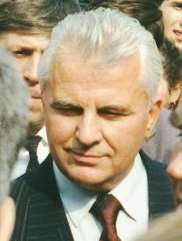
On June 22, 1990, Volodymyr Ivashko withdrew his candidacy for leader of the Communist Party of Ukraine in view of his new position in parliament. Stanislav Hurenko was elected first secretary of the CPU. On July 11, Ivashko resigned from his post as chairman of the Ukrainian Parliament after he was elected deputy general secretary of the Communist Party of the Soviet Union. The Parliament accepted the resignation a week later, on July 18. On July 16 Parliament overwhelmingly approved the Declaration on State Sovereignty of Ukraine – with a vote of 355 in favour and four against. The people's deputies voted 339 to 5 to proclaim July 16 a Ukrainian national holiday.
On July 23, 1990, Leonid Kravchuk was elected to replace Ivashko as parliament chairman. On July 30, Parliament adopted a resolution on military service ordering Ukrainian soldiers "in regions of national conflict such as Armenia and Azerbaijan" to return to Ukrainian territory. On August 1, Parliament voted overwhelmingly to shut down the Chernobyl Nuclear Power Plant. On August 3, it adopted a law on the economic sovereignty of the Ukrainian republic. On August 19, the first Ukrainian Catholic liturgy in 44 years was celebrated at St. George Cathedral. On September 5–7, the International Symposium on the Great Famine of 1932–1933 was held in Kiev. On September 8, The first "Youth for Christ" rally since 1933 took place held in Lviv, with 40,000 participants. In September 28–30, the Green Party of Ukraine held its founding congress. On September 30, nearly 100,000 people marched in Kiev to protest against the new union treaty proposed by Gorbachev.
On October 1, 1990, parliament reconvened amid mass protests calling for the resignations of Kravchuk and of Prime Minister Vitaliy Masol, a leftover from the previous régime. Students erected a tent city on October Revolution Square, where they continued the protest.
On October 17 Masol resigned, and on October 20, Patriarch Mstyslav I of Kiev and all Ukraine arrived at Saint Sophia’s Cathedral, ending a 46-year banishment from his homeland. On October 23, 1990, Parliament voted to delete Article 6 of the Ukrainian Constitution, which referred to the "leading role" of the Communist Party.
On October 25–28, 1990, Rukh held its second congress and declared that its principal goal was the "renewal of independent statehood for Ukraine". On October 28 UAOC faithful, supported by Ukrainian Catholics, demonstrated near St. Sophia’s Cathedral as newly elected Russian Orthodox Church Patriarch Aleksei and Metropolitan Filaret celebrated liturgy at the shrine. On November 1, the leaders of the Ukrainian Greek Catholic Church and of the Ukrainian Autocephalous Orthodox Church, respectively, Metropolitan Volodymyr Sterniuk and Patriarch Mstyslav, met in Lviv during anniversary commemorations of the 1918 proclamation of the Western Ukrainian National Republic.
On November 18, 1990, the Ukrainian Autocephalous Orthodox Church enthroned Mstyslav as Patriarch of Kiev and all Ukraine during ceremonies at Saint Sophia's Cathedral. Also on November 18, Canada announced that its consul-general to Kiev would be Ukrainian-Canadian Nestor Gayowsky. On November 19, the United States announced that its consul to Kiev would be Ukrainian-American John Stepanchuk. On November 19, the chairmen of the Ukrainian and Russian parliaments, respectively, Kravchuk and Yeltsin, signed a 10-year bilateral pact. In early December 1990 the Party of Democratic Rebirth of Ukraine was founded; on December 15, the Democratic Party of Ukraine was founded.[98]
Central Asian republics
Tajikistan: Dushanbe riots
On February 12–14, 1990, anti-government riots took place in Tajikistan's capital, Dushanbe, as tensions rose between nationalist Tajiks and ethnic Armenian refugees, after the Sumgait pogrom and anti-Armenian riots in Azerbaijan in 1988. During these riots, demonstrations sponsored by the nationalist Rastokhez movement turned violent. Radical economical and political reforms were demanded by the protesters which in turned torched government buildings; shops and other businesses were attacked and looted. 26 people were killed and 565 people were injured.
1991
Moscow’s crisis
On January 14, 1991, Nikolai Ryzhkov resigned from his post as Chairman of the Council of Ministers, or premier of the Soviet Union, and was succeeded by Valentin Pavlov in the newly established post of Prime Minister of the Soviet Union.
On March 17, 1991, in a Union-wide referendum 76.4 percent of voters endorsed retention of a reformed Soviet Union.[99] The Baltic republics, Armenia, Georgia, and Moldova boycotted the referendum as well as Checheno-Ingushetia (an autonomous republic within Russia that had a strong desire for independence, and by now referred to itself as Ichkeria).[100] In each of the other nine republics, a majority of the voters supported the retention of a reformed Soviet Union.
Russia’s President Boris Yeltsin

On June 12, 1991, Boris Yeltsin won 57 percent of the popular vote in the democratic elections for the newly created post of President of the Russian SFSR, defeating Gorbachev's preferred candidate, Nikolai Ryzhkov, who won 16 percent of the vote. In his election campaign, Yeltsin criticized the "dictatorship of the center," but did not yet suggest that he would introduce a market economy.
Baltic republics
Lithuania
On January 13, 1991, Soviet troops, along with the KGB Spetsnaz Alpha Group, stormed the Vilnius TV Tower in Lithuania to suppress the independence movement. Fourteen unarmed civilians were killed and hundreds more injured. On the night of July 31, 1991, Russian OMON from Riga, the Soviet military headquarters in the Baltics, assaulted the Lithuanian border post in Medininkai and killed seven Lithuanian servicemen. This event further weakened the Soviet Union's position internationally and domestically, and stiffened Lithuanian resistance.
Latvia

The bloody attacks in Lithuania prompted Latvians to organize defensive barricades (the events are still today known as "The Barricades") blocking access to strategically important buildings and bridges in Riga. Soviet attacks in the ensuing days resulted in six deaths and several injuries; one person died later.
Estonia
When Estonia had officially restored its independence during the coup (see below) in the dark hours of August 20, 1991, at 11:03 pm Tallinn time, many Estonian volunteers surrounded the Tallinn TV Tower in an attempt to prepare to cut off the communication channels after the Soviet troops seized it and wouldn’t let themselves to be intimidated by the Soviet troops. When Edgar Savisaar confronted the Soviet troops for ten minutes, they finally retreated from the TV tower after the failed resistance against the Estonian people.
August Coup

Faced with growing separatism, Gorbachev sought to restructure the Soviet Union into a less centralized state. On August 20, 1991, the Russian SFSR was scheduled to sign a New Union Treaty that would have converted the Soviet Union into a federation of independent republics with a common president, foreign policy and military. It was strongly supported by the Central Asian republics, which needed the economic advantages of a common market to prosper. However, it would have meant some degree of continued Communist Party control over economic and social life.
More radical reformists were increasingly convinced that a rapid transition to a market economy was required, even if the eventual outcome meant the disintegration of the Soviet Union into several independent states. Independence also accorded with Yeltsin's desires as president of the Russian Federation, as well as those of regional and local authorities to get rid of Moscow’s pervasive control. In contrast to the reformers' lukewarm response to the treaty, the conservatives, "patriots," and Russian nationalists of the USSR – still strong within the CPSU and the military – were opposed to weakening the Soviet state and its centralized power structure.
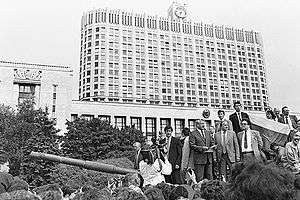
On August 19, 1991, Gorbachev's vice president, Gennady Yanayev, Prime Minister Valentin Pavlov, Defense Minister Dmitry Yazov, KGB chief Vladimir Kryuchkov and other senior officials acted to prevent the union treaty from being signed by forming the "General Committee on the State Emergency," which put Gorbachev – on holiday in Foros, Crimea – under house arrest and cut off his communications. The coup leaders issued an emergency decree suspending political activity and banning most newspapers.
Coup organizers expected some popular support but found that public sympathy in large cities and in the republics was largely against them, manifested by public demonstrations, especially in Moscow. Russian SFSR President Yeltsin condemned the coup and garnered popular support.
Thousands of Muscovites came out to defend the White House (the Russian Federation's parliament and Yeltsin's office), the symbolic seat of Russian sovereignty at the time. The organizers tried but ultimately failed to arrest Yeltsin, who rallied opposition to the coup with speech-making atop a tank. The special forces dispatched by the coup leaders took up positions near the White House, but members refused to storm the barricaded building. The coup leaders also neglected to jam foreign news broadcasts, so many Muscovites watched it unfold live on CNN. Even the isolated Gorbachev was able to stay abreast of developments by tuning into BBC World Service on a small transistor radio.[101]
After three days, on August 21, 1991, the coup collapsed. The organizers were detained and Gorbachev returned as president, albeit with his power much depleted.
The fall: August–December 1991

On August 24, 1991, Gorbachev dissolved the Central Committee of the CPSU, resigned as the party's general secretary, and dissolved all party units in the government. Five days later, the Supreme Soviet indefinitely suspended all CPSU activity on Soviet territory, effectively ending Communist rule in the Soviet Union and dissolving the only remaining unifying force in the country.
The Soviet Union collapsed with dramatic speed in the last quarter of 1991. Between August and December, 10 republics declared their independence, largely out of fear of another coup. By the end of September, Gorbachev no longer had the authority to influence events outside of Moscow. He was challenged even there by Yeltsin, who had begun taking over what remained of the Soviet government, including the Kremlin.
On September 17, 1991, General Assembly resolution numbers 46/4, 46/5, and 46/6 admitted Estonia, Latvia, and Lithuania to the United Nations, conforming to Security Council resolution numbers 709, 710, and 711 passed on September 12 without a vote.[102][103]
The final round of the Soviet Union's collapse began with a Ukrainian popular referendum on December 1, 1991, in which 90 percent of voters opted for independence. The secession of Ukraine, the second-most powerful republic, ended any realistic chance of Gorbachev keeping the Soviet Union together even on a limited scale. The leaders of the three principal Slavic republics, Russia, Ukraine, and Belarus (formerly Byelorussia), agreed to discuss possible alternatives to the union.
On December 8, the leaders of Russia, Ukraine, and Belarus secretly met in Belavezhskaya Pushcha, in western Belarus, and signed the Belavezha Accords, which proclaimed the Soviet Union had ceased to exist and announced formation of the Commonwealth of Independent States (CIS) as a looser association to take its place. They also invited other republics to join the CIS. Gorbachev called it an unconstitutional coup. However, by this time there was no longer any reasonable doubt that, as the preamble of the Accords put it, "the USSR, as a subject of international law and a geopolitical reality, is ceasing its existence."
On December 12, the Supreme Soviet of the Russian SFSR formally ratified the Belavezha Accords and renounced the 1922 Union Treaty. It also recalled the Russian deputies from the Supreme Soviet of the USSR. The legality of this action was questionable, since Soviet law did not allow a republic to unilaterally recall its deputies.[104] However, no one in either Russia or the Kremlin objected. Any objections from the latter would have likely had no effect, since the Soviet government had effectively been rendered impotent long before December. In effect, the largest and most powerful republic had seceded from the Union. Later that day, Gorbachev hinted for the first time that he was considering stepping down.[105]
On December 17, 1991, along with 28 European countries, the European Community, and four non-European countries, the three Baltic Republics and nine of the twelve remaining Soviet republics signed the European Energy Charter in the Hague as sovereign states.[106]

Doubts remained over whether the Belavezha Accords had legally dissolved the Soviet Union, since they were signed by only three republics. However, on December 21, 1991, representatives of 11 of the 12 remaining republics – all except Georgia – signed the Alma-Ata Protocol, which confirmed the dissolution of the Union and formally established the CIS. They also "accepted" Gorbachev's resignation. While Gorbachev hadn't made any formal plans to leave the scene yet, he did tell CBS News that he would resign as soon as he saw that the CIS was indeed a reality.[107]
In a nationally televised speech early in the morning of December 25, 1991, Gorbachev resigned as president of the USSR – or, as he put it, "I hereby discontinue my activities at the post of President of the Union of Soviet Socialist Republics." He declared the office extinct, and all of its powers (such as control of the nuclear arsenal) were ceded to Yeltsin. A week earlier, Gorbachev had met with Yeltsin and accepted the fait accompli of the Soviet Union's dissolution. On the same day, the Supreme Soviet of the Russian SFSR adopted a statute to change Russia's legal name from "Russian Soviet Federative Socialist Republic" to "Russian Federation," showing that it was now a sovereign state.
On the night of December 25, at 7:32 p.m. Moscow time, after Gorbachev left the Kremlin, the Soviet flag was lowered for the last time, and the Russian tricolor was raised in its place, symbolically marking the end of the Soviet Union. On that same day, the President of the United States and former CIA director George H.W. Bush held a brief televised speech officially recognizing the independence of the 11 remaining republics.
The next day, on December 26, the Council of Republics, the upper chamber of the Union's Supreme Soviet, issued a formal Declaration recognizing that the Soviet Union had ceased to exist as a functioning state and subject of international law, and voted both itself and the Soviet Union out of existence (the lower chamber, the Council of the Union, had been unable to work since December 12, when the recall of the Russian deputies left it without a quorum). The following day Yeltsin moved into Gorbachev's former office, though the Russian authorities had taken over the suite two days earlier. By the end of 1991, the few remaining Soviet institutions that had not been taken over by Russia ceased operation, and individual republics assumed the central government's role.
The Alma-Ata Protocol also addressed other issues, including UN membership. Notably, Russia was authorized to assume the Soviet Union's UN membership, including its permanent seat on the Security Council. The Soviet Ambassador to the UN delivered a letter signed by Russian President Yeltsin to the UN Secretary-General dated December 24, 1991, informing him that by virtue of the Alma-Ata Protocol, Russia was the successor state to the USSR. After being circulated among the other UN member states, with no objection raised, the statement was declared accepted on the last day of the year, December 31, 1991.
Chronology of declarations of restored states

Before the coup
-
.svg.png) Lithuania – March 11, 1990
Lithuania – March 11, 1990 -
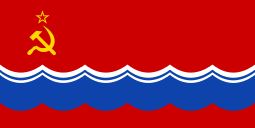 Estonia (transitional) – March 30, 1990
Estonia (transitional) – March 30, 1990 -
 Latvia (transitional) – May 4, 1990
Latvia (transitional) – May 4, 1990
During the coup
Chronology of declarations of newly independent states
States with limited recognition are shown in italics.
Before the coup
-
 Abkhazia – August 25, 1990
Abkhazia – August 25, 1990 -
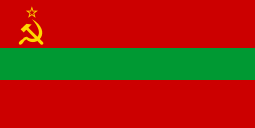 Transnistria – September 2, 1990
Transnistria – September 2, 1990 -
.svg.png) Georgia – April 9, 1991
Georgia – April 9, 1991
During the coup
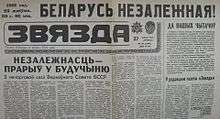
-
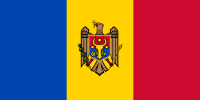 Gagauzia – August 19, 1991
Gagauzia – August 19, 1991
After the coup
-
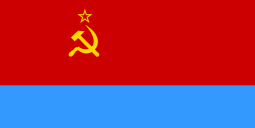 Ukraine – August 24, 1991
Ukraine – August 24, 1991 -
 Belarus/Byelorussia – August 25, 1991
Belarus/Byelorussia – August 25, 1991 -
 Moldova – August 27, 1991
Moldova – August 27, 1991 -
.svg.png) Kirghizia – August 31, 1991
Kirghizia – August 31, 1991 -
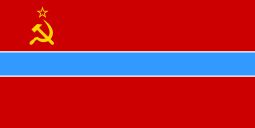 Uzbekistan – September 1, 1991
Uzbekistan – September 1, 1991 -
 Nagorno-Karabakh Republic – September 2, 1991
Nagorno-Karabakh Republic – September 2, 1991 -
.svg.png) Tajikistan – September 9, 1991
Tajikistan – September 9, 1991 -
 Armenia – September 21, 1991
Armenia – September 21, 1991 -
 Azerbaijan – October 18, 1991
Azerbaijan – October 18, 1991 -
 Turkmenistan – October 27, 1991
Turkmenistan – October 27, 1991 -
 Chechen Republic of Ichkeria – November 1, 1991
Chechen Republic of Ichkeria – November 1, 1991 -
 South Ossetia – November 28, 1991
South Ossetia – November 28, 1991 -
.svg.png) Russian SFSR – December 12, 1991 (the Supreme Soviet of the Russian SFSR formally ratified the Belavezha Accords, renounced the 1922 Union Treaty, and recalled Russian deputies from the Supreme Soviet of the USSR).
Russian SFSR – December 12, 1991 (the Supreme Soviet of the Russian SFSR formally ratified the Belavezha Accords, renounced the 1922 Union Treaty, and recalled Russian deputies from the Supreme Soviet of the USSR). -
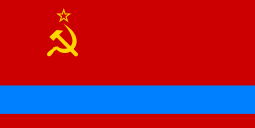 Kazakhstan – December 16, 1991
Kazakhstan – December 16, 1991
Legacy
According to a 2014 poll, 57 percent of citizens of Russia regretted the collapse of the Soviet Union, while 30 percent said they did not. Elderly people tended to be more nostalgic than younger Russians.[108] 50% of respondents in Ukraine in a similar poll held in February 2005 stated they regret the disintegration of the Soviet Union.[109]
On 25 January 2016, Russian President Vladimir Putin blamed Lenin and his advocating for the individual republics' right to political secession for the breakup of the Soviet Union.[110]
The breakdown of economic ties that followed the collapse of the Soviet Union led to a severe economic crisis and catastrophic fall in living standards in post-Soviet states and the former Eastern Bloc,[111] which was even worse than the Great Depression.[112][113] Even before Russia's financial crisis in 1998, Russia's GDP was half of what it had been in the early 1990s.[113]
United Nations membership
In a letter dated December 24, 1991, Boris Yeltsin, the President of the Russian Federation, informed the United Nations Secretary-General that the membership of the Soviet Union in the Security Council and all other UN organs was being continued by the Russian Federation with the support of the 11 member countries of the Commonwealth of Independent States.
However, the Belorussian Soviet Socialist Republic and the Ukrainian Soviet Socialist Republic had already joined the UN as original members on October 24, 1945, together with the Soviet Union. After declaring independence, the Ukrainian Soviet Socialist Republic changed its name to Ukraine on August 24, 1991, and on September 19, 1991, the Belorussian Soviet Socialist Republic informed the UN that it had changed its name to the Republic of Belarus.
The other twelve independent states established from the former Soviet Republics were all admitted to the UN:
- September 17, 1991:
 Estonia,
Estonia,  Latvia, and
Latvia, and .svg.png) Lithuania
Lithuania - March 2, 1992:
 Armenia,
Armenia,  Azerbaijan,
Azerbaijan,  Kazakhstan,
Kazakhstan, .svg.png) Kyrgyzstan,
Kyrgyzstan,  Moldova,
Moldova, .svg.png) Tajikistan,
Tajikistan,  Turkmenistan, and
Turkmenistan, and  Uzbekistan
Uzbekistan - July 31, 1992:
.svg.png) Georgia
Georgia
Explanations of Soviet Dissolution in Historiography
Historiography on Soviet dissolution can be roughly classified in two groups: intentionalist accounts and structuralist accounts.
Intentionalist accounts contend that Soviet collapse was not inevitable, and resulted from the policies and decisions of specific individuals (usually, Gorbachev and Yeltsin). One characteristic example of intentionalist writing is historian Archie Brown's The Gorbachev Factor, which argues Gorbachev was the main force in Soviet politics at least in the period 1985-1988; even later, he largely spearheaded the political reforms and developments, as opposed to 'being led by events'.[114] This was especially true of the policies of perestroika and glasnost, market initiatives, and foreign policy stance, as political scientist George Breslauer has seconded, labelling Gorbachev a "man of the events".[115] In a slightly different vein, David Kotz and Fred Weir have contended that Soviet elites were responsible for spurring on both nationalism and capitalism, from which they could personally benefit (this is also demonstrated by their continued presence in the higher economic and political echelons of post-Soviet republics).[116]
Structuralist accounts, by contrast, take a more deterministic view, in which Soviet dissolution was an outcome of deeply-rooted structural issues, which planted a 'time-bomb'. For example, Stephen Walker has argued that while minority nationalities were denied power at the Union level, confronted by a culturally-destabilizing form of economic modernization, and subjected to a certain amount of Russification, they were at the same time strengthened by several policies pursued by Soviet regime (such as indigenization of leadership, support for local languages, etc.) - which over time created conscious nations. Furthermore, the basic legitimating myths of the Soviet Union federative system – that it was a voluntary and mutual union of allied peoples – eased the task of secession/ independence.[117]
See also
References
- 1 2 (Russian) Declaration № 142-Н of the Soviet of the Republics of the Supreme Soviet of the Soviet Union, formally establishing the dissolution of the Soviet Union as a state and subject of international law.
- ↑ "Gorbachev, Last Soviet Leader, Resigns; U.S. Recognizes Republics' Independence". New York Times. Retrieved April 27, 2015.
- ↑ "The End of the Soviet Union; Text of Declaration: 'Mutual Recognition' and 'an Equal Basis'". New York Times. December 22, 1991. Retrieved March 30, 2013.
- ↑ "Gorbachev, Last Soviet Leader, Resigns; U.S. Recognizes Republics' Independence". New York Times. Retrieved March 30, 2013.
- ↑ "Михаил Сергеевич Горбачёв (Mikhail Sergeyevičh Gorbačhëv)". Archontology. March 27, 2009. Retrieved April 3, 2009.
- ↑ Carrere D'Encausse, Helene (1993). The End of the Soviet Empire: The Triumph of the Nations (English – translated by Franklin Philip ed.). New York, NY: New Republic (Basic Books) division of HarperCollins. p. 16. ISBN 0-465-09812-6.
- ↑ "Gorbachev's role in 1989 turmoil". BBC News. April 1, 2009. Retrieved March 30, 2013.
- ↑ "The Gorbachev Plan: Restructuring Soviet Power". New York Times. June 30, 1988. Retrieved March 30, 2013.
- ↑ "The Third Russian Revolution; Transforming the Communist Party". New York Times. February 8, 1990. Retrieved March 30, 2013.
- 1 2 Hough, Jerry F. (1997), pp. 124–125
- ↑ "1986: Sakharov comes in from the cold". BBC News. December 23, 1972. Retrieved March 30, 2013.
- ↑ Van Elsuwege, Peter (2008). From Soviet Republics to EU Member States: A Legal and Political Assessment of the Baltic States' Accession to the EU. Studies in EU External Relations. 1. BRILL. p. xxii. ISBN 978-90-04-16945-6.
- ↑ "Gorbachev Says Ethnic Unrest Could Destroy Restructuring Effort". New York Times. November 28, 1988. Retrieved March 30, 2013.
- 1 2 3 4 "Archived copy" (PDF). Archived from the original (PDF) on September 20, 2011. Retrieved June 17, 2011.
- ↑ "Nationalist riots in Kazakhstan: "Violent nationalist riots erupted in Alma-Ata, the capital of Kazakhstan, on 17 & 18 December 1986"". Informaworld. January 1, 1970. Retrieved December 11, 2011.
- ↑ "Soviet Riots Worse Than First Reported", San Francisco Chronicle. San Francisco, Calif.: February 19, 1987. p. 22
- 1 2 "Kazakhstan: Jeltoqsan Protest Marked 20 Years Later", RadioFreeEurope/RadioLiberty
- ↑ "Jeltoqsan Movement blames leader of Kazakh Communists", EurasiaNet
- ↑ San Francisco Chronicle. Retrieved March 27, 2010, from ProQuest Newsstand.
- ↑ Leon Aron, Boris Yeltsin A Revolutionary Life. Harper Collins, 2000. page 187
- ↑ "Soviet Releasing Some Prisoners Under New Law". New York Times. February 8, 1987. Retrieved March 30, 2013.
- ↑ Barringer, Felicity (May 24, 1987). "Russian Nationalists Test Gorbachev". New York Times. Retrieved June 23, 2011.
- ↑ Barringer, Felicity (July 26, 1987). "Tartars Stage Noisy Protest in Moscow". New York Times. Retrieved June 23, 2011.
- ↑ O'Clery, Conor. Moscow December 25, 1991: The Last Day of the Soviet Union. Transworld Ireland (2011). ISBN 978-1-84827-112-8, p. 71.
- 1 2 Conor O'Clery, Moscow December 25, 1991: The Last Day of the Soviet Union. Transworld Ireland (2011). ISBN 978-1-84827-112-8, p. 74
- ↑ Keller, Bill (November 1, 1987). "Critic of Gorbachev Offers to Resign His Moscow Party Post". New York Times.
- ↑ Keller, Bill (August 24, 1987). "Lithuanians Rally For Stalin Victims". New York Times. Retrieved June 23, 2011.
- ↑ "Latvian Protest Reported Curbed". New York Times. November 19, 1987. Retrieved March 30, 2013.
- ↑ "Estonia's return to independence 1987–1991". Estonia.eu. Retrieved March 30, 2013.
- ↑ "Ministry of Foreign Affairs of The Republic of Armenia Official Site". Armeniaforeignministry.com. October 18, 1987. Retrieved June 23, 2011.
- ↑ "Government in the Soviet Union: Gorbachev's Proposal for Change". New York Times. October 2, 1988.
- 1 2 "Union of Soviet SOSocialist Republics: Parliamentary elections Congress of People's Deputies of the USSR, 1989". Ipu.org. Retrieved December 11, 2011.
- ↑ http://www.radiojamming.puslapiai.it/article_en.htm
- ↑ "Estonia Gets Hope". Ellensburg Daily Record. Helsinki, Finland: UPI. October 23, 1989. p. 9. Retrieved March 18, 2010.
- ↑ Keller, Bill (October 4, 1988). "Estonia Ferment: Soviet Role Model or Exception?". New York Times.
- ↑ Website of Estonian Embassy in London (National Holidays)
- ↑ Walker, Edward (2003). Dissolution. Rowman & Littlefield. p. 63. ISBN 0-7425-2453-1.
- ↑ Pages 10–12 Black Garden de Waal, Thomas. 2003. NYU. ISBN 0-8147-1945-7
- ↑ Black Garden de Waal, Thomas. 2003. NYU. ISBN 0-8147-1945-7, p. 40
- ↑ Page 82 Black Garden de Waal, Thomas. 2003. NYU. ISBN 0-8147-1945-7
- ↑ Keller, Bill (September 20, 1988). "Gunfire Erupts in Tense Soviet Area". New York Times. Retrieved June 23, 2011.
- ↑ Page 69 Black Garden de Waal, Thomas. 2003. NYU. ISBN 0-8147-1945-7
- ↑ Page 83 Black Garden de Waal, Thomas. 2003. NYU. ISBN 0-8147-1945-7
- ↑ Black Garden de Waal, Thomas. 2003. NYU. ISBN 0-8147-1945-7, p. 23
- ↑ Pages 60–61 Black Garden de Waal, Thomas. 2003. NYU. ISBN 0-8147-1945-7
- ↑ Keller, Bill (June 16, 1988). "Armenian Legislature Bakcs [sic] Calls For Annexing Disputed Territory". New York Times. Retrieved June 23, 2011.
- ↑ Barringer, Felicity (July 11, 1988). "Anger Alters the Chemistry of Armenian Protest". New York Times. Retrieved June 23, 2011.
- ↑ Keller, Bill (September 23, 1988). "Parts Of Armenia Are Blocked Off By Soviet Troops". New York Times. Retrieved June 23, 2011.
- ↑ Pages 62–63 Black Garden de Waal, Thomas. 2003. NYU. ISBN 0-8147-1945-7
- ↑ Taubman, Philip (November 26, 1988). "Soviet Army Puts Armenian Capital Under Its Control". New York Times. Retrieved June 23, 2011.
- ↑ Barringer, Felicity (December 12, 1988). "Amid the Rubble, Armenians Express Rage at Gorbachev". New York Times. Retrieved June 23, 2011.
- ↑ Fein, Esther (April 25, 1989). "Kremlin Calls Georgia Violence a Local Operation". Retrieved June 24, 2014.
- ↑ Barringer, Felicity (November 29, 1988). "Tension Called High In Armenia Capital, With 1,400 Arrests". New York Times. Retrieved June 23, 2011.
- 1 2 "Independence: a timeline (PART I) (08/19/01)". Ukrweekly.com. Retrieved December 11, 2011.
- ↑ "Graves of 500 Stalin Victims Are Reported Outside Minsk". New York Times. August 18, 1988.
- ↑ Keller, Bill (December 28, 1988). "Stalin's Victims: An Uneasy Enshrinement". New York Times.
- ↑ Pages 188–189. Conor O'Clery. Moscow December 25, 1991: The Last Day of the Soviet Union. Transworld Ireland (2011)
- ↑ Clines, Francis X. (May 15, 1989). "This Time, Many Candidates for Soviet Voters". New York Times.
- ↑ Keller, Bill (May 30, 1989). "Moscow Maverick, in Shift, Is Seated in Supreme Soviet". New York Times.
- ↑ Keller, Bill (May 31, 1989). "Gorbachev Urges a Postponement of Local Voting". New York Times.
- ↑ Fein, Esther B. (October 25, 1989). "Soviet Legislature Votes to Abolish Official Seats". New York Times.
- ↑ Wolchik, Sharon L.; Jane Leftwich Curry (2007). Central and East European Politics: From Communism to Democracy. Rowman & Littlefield. p. 238. ISBN 0-7425-4068-5.
- ↑ Senn (1995), p. 78
- ↑ Cooper, Anne (September 2, 1989). "Communists in Baltics Shying From Kremlin". New York Times.
- ↑ Fein, Esther B. (December 8, 1989). "Upheaval in the East; Lithuania Legalizes Rival Parties, Removing Communists' Monopoly". New York Times.
- ↑ Page 86 Black Garden de Waal, Thomas. 2003. NYU. ISBN 0-8147-1945-7
- ↑ "Huge Azerbaijani Rally Asks Moscow to Free Prisoners". New York Times. August 20, 1989.
- ↑ Black Garden de Waal, Thomas. 2003. NYU. ISBN 0-8147-1945-7, p. 71
- ↑ Keller, Bill (September 26, 1989). "A Gorbachev Deadline on Armenia Issue". New York Times.
- 1 2 Black Garden de Waal, Thomas. 2003. NYU. ISBN 0-8147-1945-7, p. 87
- ↑ Fein, Esther B. (August 27, 1989). "11 Armenians Leave Prison, Find Celebrity". New York Times.
- ↑ Page 72 Black Garden de Waal, Thomas. 2003. NYU. ISBN 0-8147-1945-7
- ↑ "Soldiers Patrolling Soviet Georgia Amid Wave of Nationalist Protests". New York Times. April 8, 1989.
- ↑ Fein, Esther B. (April 10, 1989). "At Least 16 Killed as Protesters Battle the Police in Soviet Georgia". New York Times.
- ↑ "Soviet Troops Struggle To Curb Georgia Strife". New York Times. July 18, 1989.
- ↑ "Update on the Moldavian Elections to the USSR Congress of People's Deputies". 24 May 1989. Archived from the original on February 26, 2012. Retrieved August 9, 2012.
- ↑ Esther B. Fein, "Baltic Nationalists Voice Defiance But Say They Won't Be Provoked", in the New York Times, August 28, 1989
- ↑ King, p.140
- ↑ "Belarus Plans to Build Memorial to Stalin's Victims". New York Times. January 25, 1989.
- ↑ "Marchers in Minsk Demand Further Chernobyl Cleanup". New York Times. October 1, 1989.
- ↑ "Uzbekistan Riots Reported Quelled". New York Times. June 12, 1989.
- ↑ Fein, Esther B. (June 20, 1989). "Soviets Report an Armed Rampage in Kazakhstan". New York Times.
- ↑ Fein, Esther B. (June 26, 1989). "Rioting Youths Reportedly Attack The Police in Soviet Kazakhstan". New York Times.
- ↑ "Soviet Communist Party gives up monopoly on political power: This Day in History – 2/7/1990". History.com. Retrieved June 23, 2011.
- ↑ Acton, Edward, (1995) Russia, The Tsarist and Soviet Legacy, Longmann Group Ltd (1995) ISBN 0-582-08922-0
- ↑ Leon Aron, Boris Yeltsin A Revolutionary Life. Harper Collins, 2000. page 739–740.
- ↑ "1990: Yeltsin Resignation Splits Soviet Communists". BBC News. July 12, 1990.
- ↑ Nina Bandelj, From Communists to Foreign Capitalists: The Social Foundations of Foreign Direct Investment in Postsocialist Europe, Princeton University Press, 2008, ISBN 978-0-691-12912-9, p. 41
- ↑ "Upheaval in the East; Party in Estonia Votes Split and Also a Delay". New York Times. March 26, 1990.
- ↑ "Upheaval in the East: Azerbaijan; Angry Soviet Crowd Attacks What Is Left Of Iran Border Posts". New York Times. January 7, 1990.
- ↑ Black Garden de Waal, Thomas. 2003. NYU. ISBN 0-8147-1945-7, p. 90
- 1 2 Page 89 Black Garden de Waal, Thomas. 2003. NYU. ISBN 0-8147-1945-7
- 1 2 Page 93 Black Garden de Waal, Thomas. 2003. NYU. ISBN 0-8147-1945-7
- ↑ Black Garden de Waal, Thomas. 2003. NYU. ISBN 0-8147-1945-7, p. 94
- ↑ "Conflict, cleavage, and change in Central Asia and the Caucasus" Karen Dawisha and Bruce Parrott (eds.), Cambridge University Press. 1997 ISBN 0-521-59731-5, p. 124
- ↑ "CIA World Factbook (1995)". CIA World Factbook. Retrieved December 11, 2011.
- ↑ "Conflict, cleavage, and change in Central Asia and the Caucasus", Karen Dawisha and Bruce Parrott (eds.), Cambridge University Press. 1997 ISBN 0-521-59731-5, p. 125
- ↑ "Independence: a timeline (CONCLUSION) (08/26/01)". Ukrweekly.com. Retrieved March 30, 2013.
- ↑ 1991: March Referendum SovietHistory.org
- ↑ Charles King, The Ghost of Freedom: History of the Caucasus
- ↑ http://www.asc.upenn.edu/gerbner/Asset.aspx?assetID=883
- ↑ "Resolutions adopted by the United Nations Security Council in 1991". United Nations. Retrieved 17 June 2016.
- ↑ "46th Session (1991–1992) – General Assembly – Quick Links – Research Guides at United Nations Dag Hammarskjöld Library". United Nations. Retrieved 17 June 2016.
- ↑ The On paper, the Russian SFSR had the constitutional right to "freely secede from the Soviet Union" (art. 69 of the RSFSR Constitution, art. 72 of the USSR Constitution), but according to USSR laws 1409-I (enacted on April 3, 1990) and 1457-I (enacted on April 26, 1990) this could be done only by referendum with two-thirds of all registered voters supporting it. No special referendum on the secession from the USSR was held in the Russian SFSR
- ↑ Francis X. Clines, "Gorbachev is Ready to Resign as Post-Soviet Plan Advances", New York Times, December 13, 1991.
- ↑ "Concluding document of The Hague Conference on the European Energy Charter" (PDF). Retrieved December 11, 2011.
- ↑ Francis X. Clines, "11 Soviet States Form Commonwealth Without Clearly Defining Its Powers", New York Times, December 22, 1991.
- ↑ Sputnik (January 15, 2014). "Over Half of Russians Regret Loss of Soviet Union". ria.ru.
- ↑ "Russians, Ukrainians Evoke Soviet Union", Angus Reid Global Monitor (01/02/05)
- ↑ "Putin: Lenin's Ideas Destroyed USSR by Backing Republics Right to Secession". sputniknews.com. January 25, 2016. Retrieved January 26, 2016.
- ↑ "Child poverty soars in eastern Europe", BBC News, October 11, 2000
- ↑ "What Can Transition Economies Learn from the First Ten Years? A New World Bank Report", Transition Newsletter, World Bank, K-A.kg
- 1 2 "Who Lost Russia?", New York Times, October 8, 2000
- ↑ Brown, Archie (1997). The Gorbachev Factor. Oxford: Oxford University Press. ISBN 978-0-19288-052-9.
- ↑ Breslauer, George (2002). Gorbachev and Yeltsin as Leaders. Cambridge: Cambridge University Press. pp. 274–275. ISBN 978-0521892445.
- ↑ Kotz, David and Fred Weir. "The Collapse of the Soviet Union was a Revolution from Above". The Rise and Fall of the Soviet Union: 155–164.
- ↑ Edward, Walker (2003). Dissolution: Sovereignty and the Breakup of the Soviet Union. Oxford: Rowman & Littlefield Publishers. ISBN 978-0-74252-453-8.
Further reading
- "After the Fall: Building Nations out of the Soviet Union" (PDF). History of the International Monetary Fund 1990–1999 – Tearing Down Walls. International Monetary Fund.
- Aron, Leon. Boris Yeltsin : A Revolutionary Life. Harper Collins (2000). ISBN 0-00-653041-9
- Aron, Leon. "The 'Mystery' of Soviet Collapse." Journal of Democracy 17.2 (2006): 21-35.
- Beissinger, Mark. "Nationalism and the Collapse of Soviet Communism" Contemporary European History 18.3 (2009): 331-347.
- Brown, Archie. The Gorbachev Factor. Oxford University Press (1997). ISBN 978-0-19288-052-9.
- Cohen, Stephen. "Was the Soviet System Reformable?" Slavic Review 63.3 (2004): 459-488.
- Crawshaw, Steve. Goodbye to the USSR: The Collapse of Soviet Power. Bloomsbury (1992). ISBN 0-7475-1561-1
- Dallin, Alexander. "Causes of the Collapse of the USSR." Post-Soviet Affairs 8.4 (1992).
- Dawisha, Karen & Parrott, Bruce (Editors). "Conflict, cleavage, and change in Central Asia and the Caucasus". Cambridge University Press (1997). ISBN 0-521-59731-5
- de Waal, Thomas. Black Garden. NYU (2003). ISBN 0-8147-1945-7
- Gorbachev, Mikhail. Memoirs. Doubleday (1995). ISBN 0-385-40668-1
- Gvosdev, Nikolas K., ed. The Strange Death of Soviet Communism: A Post-Script. Transaction Publishers (2008). ISBN 978-1-41280-698-5
- Kotz, David, and Fred Weir. “The Collapse of the Soviet Union was a Revolution from Above.” In The Rise and Fall of the Soviet Union, edited by Laurie Stoff, 155-164. Thomson Gale (2006).
- Mayer, Tom. "The Collapse of Soviet Communism: A Class Dynamics Interpretation." Social Forces 80.3 (2002): 759-811.
- O'Clery, Conor. Moscow December 25, 1991: The Last Day of the Soviet Union. Transworld Ireland (2011). ISBN 978-1-84827-112-8
- Plokhy, Serhii. The Last Empire: The Final Days of the Soviet Union. Oneworld (2014). ISBN 978-1-78074-646-3
- Strayer, Robert. Why Did the Soviet Union Collapse? Understanding Historical Change. M. E. Sharpe (1998). ISBN 978-0-76560-004-2
- Suny, Ronald. Revenge of the Past: Nationalism, Revolution, and the Collapse of the Soviet Union. Stanford University Press (1993). ISBN 978-0-80472-247-6
- Walker, Edward W. Dissolution: Sovereignty and the Breakup of the Soviet Union. Rowman & Littlefield Publishers (2003). ISBN 978-0-74252-453-8
External links
- Photographs of the fall of the USSR by photojournalist Alain-Pierre Hovasse, a first-hand witness of these events.
- Guide to the James Hershberg poster collection, Special Collections Research Center, The Estelle and Melvin Gelman Library, The George Washington University. This collection contains posters documenting the changing social and political culture in the former Soviet Union and Europe (particularly Eastern Europe) during the collapse of Communism in Eastern Europe and the breakup of the Soviet Union. A significant portion of the posters in this collection were used in a 1999 exhibit at Gelman Library titled "Goodbye Comrade: An Exhibition of Images from the Revolution of '89 and the Collapse of Communism."
- Lowering of the Soviet flag in December 25, 1991
- U.S. Response to the End of the USSR from the Dean Peter Krogh Foreign Affairs Digital Archives
